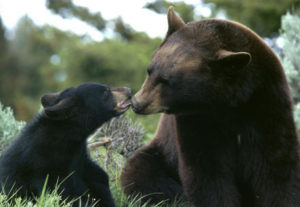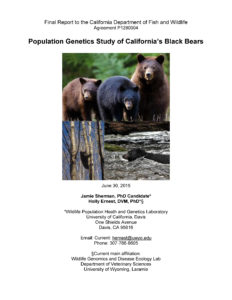Scientists conducting a multi-year study of black bears along California’s central coast have concluded that only 101 bears exist in San Luis Obispo County, much lower than previous estimates. The population count was prompted by public outcry over an earlier proposal to allow bear hunting in the county.
The study—completed in 2015 and recently released in response to a series of public requests—is the first comprehensive effort to estimate the number of black bears here. Biologists used bait to attract bears to several sampling stations throughout the county, and wrapped each station with two strands of barbed wire to capture hair as the bears passed through. Biologists regularly visited the sites, gathering the hair samples and sending them to a genetics lab for DNA analysis.
The study confirms what wildlife advocates have said all along—the county’s black bear population is too small to support a sustainable hunt.
In 2009, the California Department of Fish & Wildlife announced a controversial proposal to open a bear hunting season in San Luis Obispo County. Scientists and wildlife advocates criticized the Department for failing to perform a population count to determine whether a hunt was sustainable. Hundreds of local residents wrote letters to the Department, and the City Council and the County Board of Supervisors formally opposed the measure.
ForestWatch was an early leader in efforts to stop the hunt, arguing that the Department didn’t know how many bears even resided in the County and urging state wildlife officials to conduct a scientifically-defensible population survey while organizing community-wide opposition to the hunt.

In response to overwhelming public outcry, the Department eventually cancelled the 2009 hunt. But the agency then resurrected the proposal a year later, claiming that up to 52 bears could be hunted and killed each year and that 1,067 bears resided in the County.
ForestWatch teamed up with the Humane Society of the United States, wildlife attorney Bill Yeates, and Dr. Rick Hopkins, one of the state’s most preeminent bear biologists to demand that the Department undertake a scientifically-defensible population survey based on genetic sampling. We also argued that the bear hunt would violate state law, and challenged a companion proposal to allow bear hunting with dogs outfitted with radio transmitters. The Department withdrew both proposals and eventually agreed to undertake a more thorough count of black bears in San Luis Obispo County. That count was initiated in 2013, and the final report was published in 2015.
According to data gathered in the field, the County’s bear population is more than 90% smaller than the initial estimates used to justify the hunting proposals. According to the report’s authors, the difference “demonstrates the importance of current data driven models rather than simulation based studies.” Other findings of the study include:
- Monterey County Bears. Only four bears were found in Monterey County, providing biologists with too small of a sample size to accurately estimate the black bear population, beyond noting that the county has an “extremely low” number of bears. The report hypothesizes that barriers like highways, urban development, and reservoirs—coupled with natural barriers—may be preventing northward dispersal of bears from San Luis Obispo County to Monterey County.
- Population Genetics. The report confirms earlier studies showing that bears in San Luis Obispo and Monterey counties are part of a single population descended from bears that moved into the area from the southern Sierra Nevada. The report identifies four distinct bear populations within the state: 1) North Coast/Klamath, 2) Cascade/Sierra Nevada, 3) Central Coast and, 4) Southern California.
- Statewide Monitoring. The report suggests changing how the Department manages bear populations statewide. Historically, wildlife officials estimated the total statewide bear population by relying on the number of bears that hunters killed each year. The report recognizes that this method “has significant limitations” and recommends development of multi-year sampling plans for each of the state’s four bear populations. Instead of a statewide population, wildlife officials would monitor specific counties more intensively for 2-3 years, and re-sample them every 5-8 years.
The study was commissioned by the California Department of Fish & Wildlife and authored by Jamie Sherman, a PhD Candidate at the Wildlife Population Health and Genetics Laboratory at UC Davis, and Holly Ernest, DVM, PhD at the Wildlife Genomics and Disease Ecology Lab at the University of Wyoming.
We appreciate all of the work that went into conducting this study, and look forward to working with the Department to ensure that the report’s recommendations are implemented as soon as possible. The survival of bears along the central coast and throughout the state depends on it.








Comments are closed.